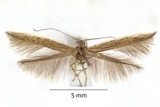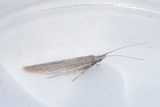Coleophora vestianella (Linnaeus, 1758) Species
Last modified: Dec. 20, 2024, 3:39 p.m.
This is a very rare species in Belgium and probably there were a lot of incorrect identifications in the past.
Details
- Classification
- Family: Coleophoridae > Genus: Coleophora > Species: Coleophora vestianella
- Vernacular names
- Zandmeldekokermot (NL), Eastern case-bearer (EN)
- Synonyms
- Coleophora laripennella (Zetterstedt, 1839) and Coleophora annulatella Tengström, 1848
- First mention in Belgium
- De Fré Ch. 1860. Lépidoptères nouvellement découverts en Belgique. — Annales de la Société entomologique belge 4: 113–115. On page 114 (as Coleophora annulatella. Tengst.). view page
- Status
-
Native
Distribution
Caterpillar
The caterpillar is pale yellowish with a pale brown head.
Case
The final case is trivalved and 6–7 mm in length with a mouth angle of 30°–35°.
See also bladmineerders.be.
Bionomics
The eggs are deposited on a flower of the food plant. The larvae feed on the seeds and need to enlarge their case several times. Therefore the oldest parts are darker and covered with frass grains and detritus while the younger strips are much lighter and clean.
The larvae start constructing a case only in September and are fully fed in October.
Pupation happens in spring inside the case and mostly at ground level.
Flight periods
The adults are on the wing from the end of June till early August.
Observed on
- Host plant (species):
- Atriplex patula and Chenopodium album
- Host plant (genera):
- Atriplex and Chenopodium
The larva feed on Atriplex and Chenopodium.


